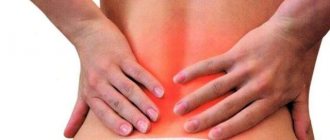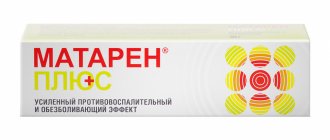Nosological classification (ICD-10)
- B02 Herpes zoster
- G50 Trigeminal nerve lesions
- G51 Lesions of the facial nerve
- G54.0 Lesions of the brachial plexus
- G54.9 Damage to nerve roots and plexuses, unspecified
- G58.0 Intercostal neuropathy
- G62.1 Alcoholic polyneuropathy
- G62.9 Polyneuropathy, unspecified
- G63.2 Diabetic polyneuropathy (E10-E14+ with common fourth character .4)
- G90.9 Autonomic nervous system disorder, unspecified
- H48.1 Retrobulbar neuritis in diseases classified elsewhere
- M54.1 Radiculopathy
- M54.4 Lumbago with sciatica
- M79.1 Myalgia
- M79.2 Neuralgia and neuritis, unspecified
- R25.2 Cramp and spasm
- R52 Pain not elsewhere classified
- R56.8 Other and unspecified convulsions
Compound
| Solution for intramuscular administration | 1 amp. (2 ml) |
| active ingredients: | |
| thiamine hydrochloride | 100 mg |
| pyridoxine hydrochloride | 100 mg |
| cyanocobalamin | 1 mg |
| lidocaine hydrochloride | 20 mg |
| excipients: benzyl alcohol - 40 mg; sodium polyphosphate or sodium tripolyphosphate - 20 mg; potassium hexacyanoferrate - 0.2 mg; sodium hydroxide solution 1 M - to pH 4–5; water for injection - up to 2 ml |
Pharmacodynamics
Neurotropic B vitamins have a beneficial effect on inflammatory and degenerative diseases of the nerves and musculoskeletal system. In high doses, they have analgesic properties, increase blood flow, normalize the functioning of the nervous system and the process of hematopoiesis.
Thiamine (B1) plays a key role in carbohydrate metabolism processes, which are crucial in the metabolic processes of nervous tissue, as well as in the Krebs cycle, with subsequent participation in the synthesis of TPP (thiamine pyrophosphate) and ATP. Pyridoxine (B6) is involved in the metabolism of proteins and partly in the metabolism of carbohydrates and fats. The physiological function of both vitamins (B1, B6) is to potentiate each other’s action, manifested in a positive effect on the nervous, neuromuscular and cardiovascular systems.
Cyanocobalamin (B12) is involved in the synthesis of the myelin sheath, stimulates hematopoiesis, reduces pain associated with damage to the peripheral nervous system, and stimulates nucleic acid metabolism through the activation of folic acid.
Lidocaine is a local anesthetic.
Vitamin B6 and carpal tunnel syndrome
Sometimes it happens that a person wakes up with a feeling of numbness in the fingers. Neurologists call this condition tunnel syndrome. The cause of this disease lies in the wrist area, where there is a special canal (tunnel) through which the median nerve passes. It innervates the second, first and third fingers of the hand, and thanks to this nerve, these three fingers sense and carry out movements. In people with a certain type of activity, when the load is placed on the hand or the work is accompanied by vibration, the transmission of impulses along the median nerve is disrupted, and the fingers become numb as a result. To treat carpal tunnel syndrome, the doctor may prescribe a course of vitamin B6 injections and physical therapy. Using a needle, a drug containing B6 is injected directly into the tunnel, as a result of which inflammation, numbness and pain go away. Typically, for carpal tunnel syndrome, 3 to 5 injections are given, and such therapy has a very long-lasting effect.
Pharmacokinetics
After intramuscular administration, thiamine is quickly absorbed from the injection site and enters the blood (484 ng/ml after 15 minutes on the first day of administration of a 50 mg dose) and is unevenly distributed in the body (in leukocytes 15%, erythrocytes 75% and blood plasma 10% ). Due to the lack of significant reserves of the vitamin in the body, it must be ingested daily. Thiamine penetrates the blood-brain barrier and the placental barrier and is found in breast milk. Thiamine is excreted in the urine in the alpha phase after 0.15 hours, in the beta phase after 1 hour and in the terminal phase within 2 days. The main metabolites are thiamine carboxylic acid, pyramine and some unknown metabolites. Of all the vitamins, thiamine is stored in the body in the smallest quantities. The adult human body contains about 30 mg of thiamine: 80% in the form of thiamine pyrophosphate, 10% thiamine triphosphate and the rest in the form of thiamine monophosphate. After intramuscular injection, pyridoxine is quickly absorbed into the bloodstream and distributed in the body, acting as a coenzyme after phosphorylation of the CH2OH group in the 5th position. About 80% of the vitamin binds to blood plasma proteins. Pyridoxine is distributed throughout the body, penetrates the placenta, and is found in breast milk. Deposited in the liver and oxidized to 4-pyridoxic acid, which is excreted in the urine, a maximum of 2–5 hours after absorption. The human body contains 40–150 mg of vitamin B6, its daily elimination is about 1.7–3.6 mg with a replacement rate of 2.2–2.4%.
COMPLIGAM IN COMPLEX TAB No. 60
Clinical and pharmacological group
Vitamin B complex. Pharmacological action
A combination product containing B vitamins and lidocaine.
Neurotropic B vitamins have a beneficial effect on inflammatory and degenerative diseases of the nerves and musculoskeletal system. They are not used to eliminate deficiency conditions, but in large doses they have analgesic properties, increase blood flow, normalize the functioning of the nervous system and the process of hematopoiesis (vitamin B12).
Thiamine (vitamin B1) plays a key role in the processes of carbohydrate metabolism, which are crucial in the metabolic processes of nervous tissue, also in the Krebs cycle with subsequent participation in the synthesis of thiamine pyrophosphate and ATP. Pyridoxine (vitamin B6) is involved in the metabolism of proteins, and partly in the metabolism of carbohydrates and fats. The physiological function of both vitamins (B1 and B6) is to potentiate each other’s action, manifested in a positive effect on the nervous, neuromuscular and cardiovascular systems.
Cyanocobalamin (vitamin B12) is involved in the synthesis of the myelin sheath, stimulates hematopoiesis, reduces pain associated with damage to the peripheral nervous system, and stimulates nucleic acid metabolism through the activation of folic acid.
Lidocaine is a local anesthetic that causes all types of local anesthesia.
Pharmacokinetics
Suction and distribution
After intramuscular administration, thiamine is quickly absorbed from the injection site and enters the blood (484 ng/ml after 15 minutes on the first day of administration of a 50 mg dose) and is distributed unevenly in the body with its content in leukocytes of 15%, erythrocytes of 75% and in plasma blood 10%. Due to the lack of significant reserves of the vitamin in the body, it must be ingested every day. Thiamine penetrates the blood-brain barrier and the placental barrier and is excreted in breast milk.
After an intramuscular injection, pyridoxine is quickly absorbed into the bloodstream and distributed in the body, acting as a coenzyme after phosphorylation of the CH2OH group in the 5th position. About 80% of pyridoxine is bound to plasma proteins. Pyridoxine is distributed throughout the body, penetrates the placental barrier, and is excreted in breast milk.
Metabolism
The main metabolites are: thiaminecarboxylic acid, pyramine and some unknown metabolites. Of all the vitamins, thiamine is stored in the body in the smallest quantities. The adult human body contains within 30 mg of thiamine in the form of: 80% in the form of thiamine pyrophosphate, 10% thiamine triphosphate and the rest in the form of thiamine monophosphate.
Removal
Thiamine is excreted in the urine in the alpha phase after 0.15 hours, in the beta phase after 1 hour and in the terminal phase over 2 days.
Pyridoxine is deposited in the liver and oxidized to 4-pyridoxine acid, which is excreted in the urine, a maximum of 2-5 hours after absorption. The human body contains 40-150 mg of vitamin B6, its daily elimination rate is in the range of 1.7–3.6 mg with a replenishment rate of 2.2-2.4%.
Indications for use of the product CompligamV
For pathogenetic and symptomatic treatment of diseases and syndromes of the nervous system of various origins:
- neuropathy and polyneuropathy (diabetic, alcoholic and others);
- neuritis and polyneuritis, incl. retrobulbar neuritis;
- peripheral paresis, incl. facial nerve;
- neuralgia, incl. trigeminal nerve and intercostal nerves;
- pain syndrome (radicular, myalgia);
- night muscle cramps, especially in older age groups;
- plexopathies, ganglionitis (including herpes zoster);
- neurological manifestations of spinal osteochondrosis (radiculopathy, lumbar ischialgia, muscular-tonic syndromes).
Dosage regimen
In case of severe pain syndrome, it is advisable to begin treatment with intramuscular injection (deep) of 2 ml of the product every day for 5-10 days, with subsequent transition either to oral administration or to more rare injections - 2-3 times a week for 2 -3 weeks.
Side effect
Allergic reactions: skin reactions in the form of itching, urticaria; not often - hypersensitivity reactions to the product, incl. rash, difficulty breathing, angioedema, anaphylactic shock.
Other: in some cases - increased sweating, tachycardia, acne.
Contraindications to the use of the CompligamV product
- severe and acute forms of decompensated chronic heart failure;
- children's age (due to lack of research);
- high sensitivity to product components.
Pregnancy and lactation
It is not recommended to use the product during pregnancy and lactation (breastfeeding).
special instructions
In cases of very rapid administration of the product, systemic reactions may develop (dizziness, arrhythmia, convulsions).
Overdose
Symptoms: possible development of systemic reactions - dizziness, arrhythmia, convulsions.
Treatment: symptomatic therapy.
Drug interactions
Pyridoxine is not prescribed simultaneously with levodopa, since the effect is weakened later.
Taking into account the presence of lidocaine in the product, in the case of additional use of epinephrine and norepinephrine, increased side effects on the heart are possible. In case of overdose of local anesthetics, additional epinephrine and norepinephrine should not be used.
Pharmaceutical interactions
Thiamine completely decomposes in solutions containing sulfites.
Thiamine is unstable in alkaline and neutral solutions; administration with carbonates, citrates, barbiturates, and copper products is not recommended.
Vitamin B12 is incompatible with ascorbic acid and heavy metal salts.
Conditions for dispensing from pharmacies
The drug is available with a prescription.
Storage conditions and periods
List B. C The drug should be stored out of reach of children, protected from light at a temperature of 2° to 8°C. Shelf life: 2 years.
Indications of the drug Compligam B®
As a pathogenetic and symptomatic remedy in the treatment of syndromes and diseases of the nervous system of various origins:
neuropathy and polyneuropathy, incl. diabetic, alcoholic;
neuritis and polyneuritis, incl. retrobulbar neuritis;
peripheral paresis, incl. facial nerve;
neuralgia, incl. trigeminal nerve and intercostal nerves;
pain syndrome (radicular, myalgia);
night muscle cramps, especially in older age groups;
plexopathies, ganglionitis (including herpes zoster);
neurological manifestations of spinal osteochondrosis (radiculopathy, lumbar ischialgia, muscular-tonic syndromes).
Interaction
Thiamine completely decomposes in solutions containing sulfites.
Thiamine is unstable in alkaline and neutral solutions; administration with carbonates, citrates, barbiturates, and copper preparations is not recommended.
Pyridoxine is not prescribed simultaneously with levodopa, since the effect of the latter is weakened.
Taking into account the presence of lidocaine in the composition of the drug, in the case of additional use of adrenoline and norepinephrine, increased side effects on the heart are possible. In case of overdose of local anesthetics, additional adrenoline and norepinephrine should not be used.
Vitamin B12 is incompatible with ascorbic acid and heavy metal salts.
Vitamin B17 and cancer treatment
Recently, scientists in search of a cure for cancer are increasingly paying close attention to vitamin B17 (amegdalin), which is found in flax seeds, millet and fruit seeds. Medical debate about the benefits and harms of this substance in the treatment of oncology does not subside. There are a number of studies that suggest that vitamin B17 helps in the fight against cancer. This opinion is shared by a number of medical specialists (American Dr. Krebs and Edward Griffin, Italian Dr. Guidetti), who consider cancer to be a disease caused by a lack of certain elements in the body. They claim that daily consumption of 7-10 apricot kernels prevents the development of cancer. And if cancer has already developed, then with dosed use of vitamin B17, tumor development decreases and the formation of metastases is stopped. But at the moment there are no generally accepted clinical studies confirming the therapeutic effect of vitamin B17 in the treatment of cancer. There are also a number of statements by the American oncologist Lester M Crawford that there is no scientific evidence that drugs with vitamin B17 (for example, laetrile) can cure cancer. Moreover, he believes that B17 is a dangerous compound that contains the deadly component cyanide. But, despite the skepticism of official medicine about the ability of vitamin B17 to help treat cancer, doctors do not give up attempts to study B vitamins as a promising group of substances in the treatment of cancer. Now active experiments are being conducted with vitamin B1.
Author: Telegina Natalya Dmitrievna
Therapist with 25 years of experience
>









